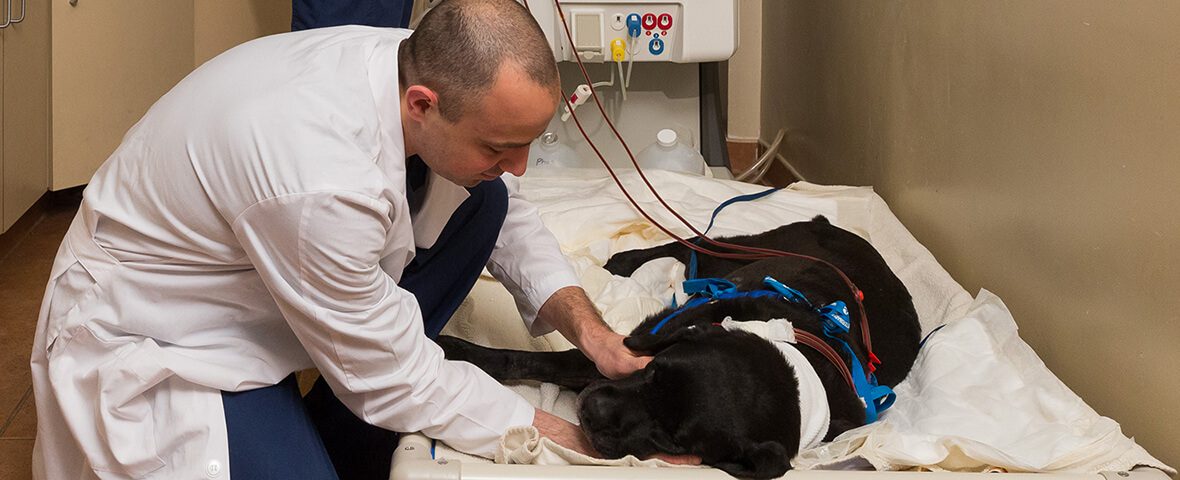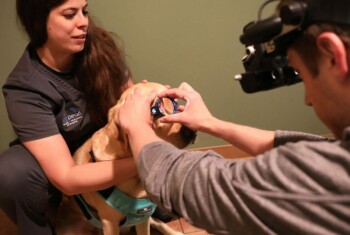Laparoscopic cryptorchidectomy in dogs and cats: Signs and treatment.
Normally, male puppies and kitten’s testicles are located within the abdomen before birth. Within the first three months of life, the testicles should descend into the scrotum.
Cryptorchidism, a condition in which one or both testicles do not descend into the scrotum, is more commonly found in purebred dogs. It is believed that this condition has a genetic basis, therefore breeding of affected animals is not recommended.
The testicles are intended to be in the scrotum, as they require a lower temperature to function normally. Testicles located within the abdomen usually do not produce sperm. The production of testosterone, however, is not affected by the intra-abdominal location of the testicle. If a dog has both testicles located within the abdomen male characteristics will still be present, but the dog will be sterile (cannot procreate). If one testicle is within the scrotum and one testicle within the abdomen, the affected pet should be able to produce sperm and sire offspring.
Signs and symptoms.
Breeds that are predisposed to this condition include cocker spaniels, Chihuahuas, miniature schnauzers  and Persian cats. Testicles located within the abdomen are prone to developing cancer and this is believed to be due to the increased testicular temperature.
and Persian cats. Testicles located within the abdomen are prone to developing cancer and this is believed to be due to the increased testicular temperature.
The most common type of testicular cancer that develops in these cases is called a Sertoli cell tumor. These tumors can cause feminization of a male dog, as they produce excessive amounts of estrogen. Clinical signs of male feminization include enlargement of the nipples, enlargement of the mammary glands, thin hair coat, a stripe of inflammation located on the prepuce, and pale gums due to anemia. If the tumor spreads to other organs in the body, weight loss, loss of appetite, malaise, breathing difficulties and death may occur.
Another potential complication of a cryptorchid testicle may be torsion, or twisting of the blood vessels around the spermatic duct. Initially, the veins that drain blood from the testicle are occluded, yet the artery will continue to pump blood into the testicle. The result is a very a painful congested testicle that results in acute abdominal pain (dog assumes a praying position with forelimbs flat on the ground and rump elevated), depression, vomiting and loss of appetite.
Laparoscopic cryptorchidectomy technique.
Laparoscopic surgery usually is performed on an outpatient basis, meaning that your companion likely will not need to spend the night in the hospital. A scope (camera) is inserted into the abdominal cavity through a 1 cm incision. Via this port, an operating telescope is placed into the abdomen; the testicle is grasped with forceps and pulled out of the abdominal incision. Because cryptorchid testicles are typically much smaller than testicles within the scrotum, they usually can be pulled through the telescope port.
Results.
The prognosis following neuter via laparoscopic surgery removal is excellent, provided that the abdominal testicle does not have cancer in it and that there is no spread of cancer to other organs. If cancer of the testicle is found, a consultation with an oncologist will be recommended.
Benefits of the laparoscopic cryptorchidectomy vs. open surgery
- Small single incision, therefore less risk for abdominal hernias
- Reduced bruising/swelling of the abdominal incision
- Less postsurgical pain
- Quicker and better recovery
- Reduced risk of surgical errors made such as inadvertent removal of the bladder or prostate
- Prevents life-threatening transformation of an intra-abdominal testicle into cancer
- The procedure can be performed on an outpatient basis, and the patient can go home on the day of the procedure
For more information on this subject, speak to the veterinarian who is treating your pet.


